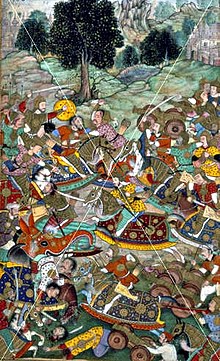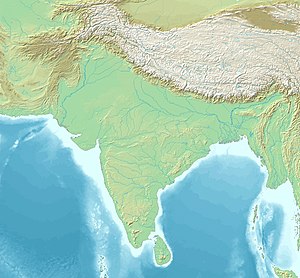
Back معركة خانوه Arabic Batalla de Khanua Spanish نبرد خنوه Persian Khanuan taistelu Finnish खानवा का युद्ध Hindi ಖನ್ವಾ ಕದನ Kannada خانوا نورد MZN ਖਾਨਵਾ ਦੀ ਲੜਾਈ Punjabi کھنوا دی لڑائی PNB Битва при Кхануа Russian
This article may require cleanup to meet Wikipedia's quality standards. The specific problem is: This article may have different opinions. (June 2022) |
| Battle of Khanwa | |||||||||
|---|---|---|---|---|---|---|---|---|---|
 Mughal painting depicting the Rajput Army (left) battling the Mughal Army (right) | |||||||||
| |||||||||
| Belligerents | |||||||||
|
|
Vassal states:
| ||||||||
| Commanders and leaders | |||||||||
|
Babur Humayun Bairam Khan Ustad Ali Quli Mustafa Rumi Chin Timur Khan Mir Khalifa Mir Abdul Aziz Mir Muhammed Ali Khan Khusrau Shah Kokultash Kasim Husein Khan Zaman Mirza Askari Mirza Hindal Mirza Sayyid Mahdi Khawaja Asad Malik Hast |
Rana Sanga (WIA) Prithviraj Kachwaha Maldev Rathore Kalyanmal rathod Uday Singh of Vagad † Bharmal Rathod Medini Rai Hasan Khan Mewati † Ratan Singh of Merta † Manik Chand Chauhan † Chandrabhan Chauhan † Ratan Singh Chundawat † Kam Dev Singh Sikarwar † Raja Dham Dev Rao Raj Rana Ajja Jhala of Bari Sadri † Haridas Kesaria † Rao Ramdas Gokaldas Parmar † Rajrana sajja jhala of delwara † Silhadi (Joined Mughal Army in the middle of battle) (AWOL) | ||||||||
| Strength | |||||||||
|
Total: 80,000 (possibly) [2]
|
Total: 110,000+[6]
| ||||||||
| Casualties and losses | |||||||||
| Heavy[7] | Heavy[7] | ||||||||
Location within South Asia | |||||||||
The Battle of Khanwa was fought at Khanwa on 16 March 1527. It was fought between the invading Timurid forces of Babur and the Kingdom of Mewar led by Rana Sanga for supremacy of Northern India.[8] The battle was a major event in Medieval Indian history although Timurids won at Panipat but at the time, the sultanate at Delhi was a spent force that was long crumbling. To the contrary, Kingdom of Mewar under the able rule of Rana Sanga and his predecessors, had turned into one of the strongest powers of northern India.[9] The battle was among the most decisive battles in the Mughal conquest of northern India.[10][11][12] It was among the earliest battles in Northern India where gunpowder was used to a great extent. The battle resulted in heavy casualties for both Timurids and Rajputs.[13]
- ^ Majumdar, R. C (1974). History and Culture of the Indian People, Volume 07, The Mughul Empire. Bharatiya Vidya Bhavan. p. 37.
- ^ Somani, R.V (1976). History of Mewar: from earliest times to 1751 A.D. C.L Ranka Jaipur. p. 173.
We do not exactly know the strength of Babar's army also, According to Afshana-e-Shakan, he was having 80,000 cavalry under him.
- ^ Military History of India by Jadunath Sarkar p. 58 – "Cavalry was formed in divisions, 5,000 under Humayun, 3,000 under Mahdi Khwaja, 10,000 under Babur and 2,000 elite horsemen in reserve for Taulqama"
- ^ Military History of India by Jadunath Sarkar p. 56
- ^ Military History of India by Jadunath Sarkar p. 59 – "The Indian allies of Babur were posted in his left wing"
- ^ Har Bilas Sarda (1918). Maharana Sanga, the hindupat; the last great leader of Rajput Race. Scottish Mission Industries. p. 144. ISBN 978-0-521-25119-8.
The Maharana's army consisted of his own and that of the great chieftains who acknowledged his allegiance. Raja Silhidi, the Rajput Chief of Bhilsa and Raisen, commanded 35,000 horses; Rawal Udai Singh of Dungarpur and Hasan Khan Mewati, 12,000 each; Raja Medni Rai of Chanderi, 10,000 horse; Narbad Hada of Boondi, 7,000; Khinchi Shatrudeva of Gagrone, 6,000; Bhar Mai of Idar, Rao Viramdeva of Merta and Chauhan Narsinghdeva, 4,000 each. Sultan Mahmud Lodi, a son of Sikandar Lodi, commanded 1 0,000 adventurers; various other chiefs had from 4,000 to 7,000 men. Rai Mai Rathor, Commander-in-chief of Jodhpur, and Kanwar Kalyan Mai, heir of Bikaner, commanded 3,000 each.
- ^ a b Eraly, Abrahim (2007). Emperors of the Peacock Throne: The Saga of the Great Moghuls. Penguin UK. ISBN 9789351180937.
The battle of Khanua was a virtual replay of the battle of Panipat, except that it lasted nearly double the time and was far more fiercely contested, resulting in heavy casualties on both sides
- ^ Giles Tillotson (1991). Mughal India. Penguin Books. p. 4. ISBN 978-0-14-011854-4.
He was immediately challenged by assembled Rajput forces under Rana Sanga of Chittor who was reckoned by Babur as one of the two greatest Hindu rulers.
- ^ V.S Bhatnagar (1974). Life and Times of Sawai Jai Singh, 1688–1743. Impex India. p. 6.
From 1326, Mewar's grand recovery commenced under Lakha, and later under Kumbha and most notably under Sanga, till it became one of the greatest powers in northern India during the first quarter of sixteenth century
- ^ An Advanced History of India. By R.C. Majumdar ... H.C. Raychaudhuri ... Kalikinkar Datta. (Second Edition.). Macmillan & Company. 1950. p. 419.
The battle of khanua was one of the most decisive battles in Indian history certainly more than that of Panipat as Lodhi empire was already crumbling and Mewar had emerged as major power in northern India. Thus, Its at Khanua the fate of India was sealed for next two centuries
- ^ Radheyshyam Chaurasia (2002). History of Medieval India: From 1000 A.D. to 1707 A.D. Atlantic Publishers & Dist. p. 161. ISBN 978-81-269-0123-4.
The battle of Kanwaha was more important in its result even than the first battle of Panipat. While the former made Babur ruler of Delhi alone the later made him King of Hindustan. As a result of his success the Mughal empire was established firmly in India. The sovereignty of India now passed from Rajputs to Mughals
- ^ Wink 2012, p. 27: "The victory of Mughals at khanua can be seen as a landmark event in Mughal conquest of North India as the battle turned out to be more historic and eventful than one fought near Panipat. It made Babur undisputed master of North India while smashing Rajput powers. After the victory at khanua, the centre of Mughal power became Agra instead of Kabul and continue to remain till downfall of the Empire after Aalamgir's death."
- ^ R.S Sharma (1999). Mughal Empire in India: A Systematic Study Including Source Material. Atlantic Publishers & Dist. p. 46. ISBN 978-81-7156-818-5.
Results: The victory of Babur, was nevertheless final and complete. 'Hardly a clan of the Rajputs was there but had lost the flower of its princely blood'. The consequences of the battle of Khanwa were most momentous. (i) The menace of the Rajput supremacy, which had loomed large before the eyes of the Muhammadans in India for the last ten years, was removed once for all

